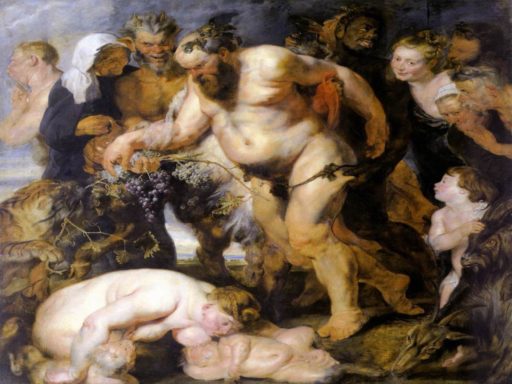Morgan Meis, one of Close Reading’s bloggers, has written a book that forces me to ask, as few books have done in a long while, not only who I am but how I am to be. A book that puts me on the spot about what it means that I’m a mortal being, destined for death. And not only what it means (if such meaning, the meaning of one’s mortality, can even be stated) but how that meaning should affect me, shape my behavior going forward, blundering forward, into…well, darkness.
What kind of a book puts a reader through a wringer like that?
On the face of it, Meis’s book, The Drunken Silenus: On Gods, Goats, and the Cracks in Reality, doesn’t sound in any way up the task. I could describe it as a brief (173 pages) meditation on the 1617 painting “The Drunken Silenus” by Peter Paul Rubens. Or elaborate further: a meditation in which Meis reimagines what inspired Rubens four hundred years ago to embody in oil paint the misery of the obese, drunken, deathless satyr Silenus, tutor of Dionysius, as he stumbles towards us across the canvas from right to left surrounded by carousing nymphs, satyrs, as well as goats, tigers, and fat little horned cherubs. The air reeks of wine and sex. The other satyrs are egging him on, pinching him, tormenting him, forcing him to try the impossible, to pitch forward through the invisible wall of the picture plane to sprawl sweating and stinking in our laps.
Intriguing to say the least, right? But how, with what appears such a limited if lively focus, could a writer lead me—a reader normally suspicious of overreaching—out of that art-historical framework into an existential challenge of the ultimate sort?
The answer is style—one that catches me unawares, from my blind side, much as the satyrs catch Silenus himself, tilting him off balance and sending him reeling with a surprise pinch and a push.
Here’s a taste of how it works.
“I started writing this book while living in Antwerp,” Meis says, in the first sentence of the Preface. Fine. What I’d expect. Peter Paul Rubens lived and worked in Antwerp, so of course Meis would go there to research and write about his topic. All’s well. I get a cup of tea and start to get settled in.
But then, instead of continuing along the well-worn path of conscientious academic table-setting, Meis drops his diction and starts gabbing about being in Antwerp only to keep his wife company because she, at least, had a serious project (film) there. He, by contrast, was doing the dishes—though he was in possession of some grant money to “write on art and what-not”
OK, so lots of time and change on his hands, right? Gotta fill it up somehow, right? And so:
Suddenly, or so it seems to me now, I remembered that Antwerp was among other things Peter Paul Rubens’ town. This thought annoyed me, as I had no interest in Rubens. I didn’t even care about him enough to dislike him. My next thought was, “I’ll write a book about him.”
See what I mean? Surprise, also cheekiness, maybe even arrogance. Or maybe insanity? Maybe all of the above. But in any case, as a reader, I’m on my back foot. I can’t imagine how anything resembling a book on Rubens or whomever else could come out of such flaunted ignorance and brazenness.
And so of course I read on, out of curiosity, even eagerness to see this clown fall completely on his face—and right away it’s I who am falling, into to the heart of the matter.
It’s a heart, I soon learn to my surprise, with many chambers, all connected by spiraling excursions back in time through Antwerp in the late 1500s, then back and forward through the religious wars to Friedrich Nietzsche in the nineteenth century as he composes The Birth of Tragedy, where the importance of Silenus is first reimagined for our time as speaking the truth of the human condition, then into the bombings and annihilations of the wars to follow. And finally branching back into Silenus’s mythic origin in ancient Greece’s Dionysian rites and back before that to the annihilation of all previous culture, Mycenaean and Hittite, by the advent of the mysterious Sea Peoples with their black ships. An ongoing, rear-going cycle of creation and destruction, living and dying, pulsing through human history as far as one can see in every direction through the arteries of time….
But the chambers of this heart, vast and vertiginously connected as they seem, take their rhythm from a key event concerning Silenus, an event that occurs, Meis imagines— taking his cue from Rubens and Ovid— not in the painting itself, but just before it.
It’s not really his satiric companions who give the drunken old fellow pain. It’s Silenus’s grief caused by his just-concluded encounter with King Midas, that lucky man for whom everything, including his daughter, turned to gold.
The story is this: King Midas imprisoned Silenus in order to force him to answer a question, the answer that has apparently eluded the king despite all his power and fortune.
The question is: What is the best thing for man?
Silenus’s reluctant answer: The best thing for man is never to have been born, but having been so unlucky as to have been born, the best thing is to die as soon as possible.
Midas is bewildered, angered by that answer, just as we probably are. Not what the king wanted or expected! Is Silenus fooling with him?
Not at all, says Meis. Just look at Rubens’ painting, just look at what answering that question did to the wretched old immortal wiseman.
Midas insisted that Silenus provide some comforting word about the human condition. But Silenus has none to give. Human life is what it is, a living and a dying— actually, a living into death, but also a living made meaningful by death.
Midas hates the answer, fears it. Depressing! Pessimistic! But Silenus knows otherwise because, being immortal, he is doomed to something far worse: a twilight state of all-too-fleshly life that just keeps on going in a staggering circle of drunken, sexy excess. Life in abundance, you say. But too much, too much. No way out. The muddle is eternal. You just keep lurching and stumbling forever towards a threshold you can never cross. You can never die.
But we, observing Rubens’s painting, reading Meis’s book, do die. Silenus’s plight, so beautifully, compassionately rendered in both places, by both artists, teaches us indirectly a truth vitally important, a truth we perhaps cannot confront or grasp directly, that we have to stumble into:
Rubens shows us a Silenus who in his struggling and stumbling would become one with man, a being-toward-death along with the rest of us. Rubens shows us a drunken immortal who would give anything to participate in the world we have been given, the brief and seemingly meaningless world of human existence.
After getting his PhD in English literature, George Dardess taught close reading to his own students until his retirement. Since then he has been ordained a Deacon in the Roman Catholic Church and written several books on Muslim-Christian relations. He has also created the graphic novel Foreign Exchange.





